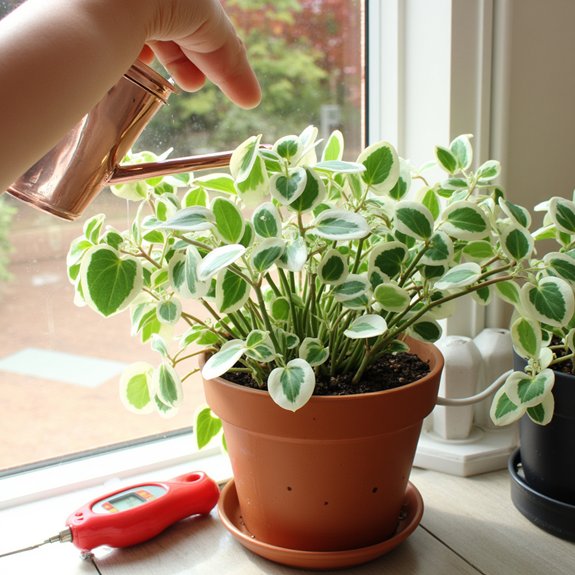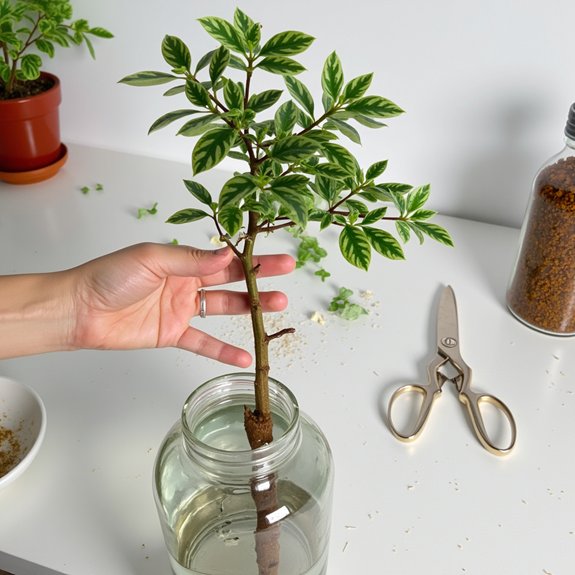Surprisingly, ninety percent of Peperomia Frost owners struggle with proper watering schedules, often killing their plants within six months. This silvery-leafed beauty demands specific care routines that differ drastically from typical houseplants, requiring precise humidity levels and strategic light placement. Most plant enthusiasts make three critical mistakes during their first year of ownership, but understanding these common pitfalls can transform anyone into a successful Peperomia parent who enjoys years of stunning, frost-like foliage.
Contents
Getting to Know Your Silver Frost Peperomia

The leaf characteristics define this variety’s appeal. Heart-shaped leaves display deep green veins contrasted against silvery-white surfaces, creating a metallic appearance that’s both striking and elegant. These thick, succulent-like leaves help the plant retain moisture, making it surprisingly forgiving for beginners. Growing 8-12 inches tall, it’s perfectly sized for desks, shelves, or windowsills.
Creating the Perfect Growing Environment
While many houseplants demand precise conditions, Peperomia Frost adapts well to typical home environments with just a few key adjustments. Position it in bright, indirect light near an east or north-facing window. Direct sunlight burns those beautiful silver leaves, so avoid south-facing windows.
The ideal lighting conditions mirror its rainforest origins, where filtered light reaches through tree canopies. Humidity requirements aren’t excessive, but maintaining 50% humidity keeps leaves vibrant. Use a humidifier, group plants together, or place it on a pebble tray with water. Regular misting helps, though it’s not essential for survival.
Watering Techniques for Healthy Growth

Because Peperomia Frost stores water in its thick, succulent-like leaves, it’s more forgiving of missed waterings than most houseplants. The ideal watering frequency falls between every 7-10 days, but soil moisture should dictate timing, not the calendar.
Bottom watering proves superior to traditional top-down methods for this plant. Place the pot in a shallow dish filled with water, allowing the roots to absorb moisture from below for 15-20 minutes. This technique prevents water from sitting on the delicate leaves, which can cause rot.
Check soil weekly by inserting a finger one inch deep—if dry, it’s time to water.
Essential Maintenance and Fertilizing Tips
Although Peperomia Frost requires minimal daily attention, proper fertilizing and basic maintenance will keep those distinctive silver leaves looking their best year-round. Apply liquid fertilizer once monthly during spring through autumn, skipping winter months entirely. Different fertilizer types work well, but balanced houseplant formulas deliver consistent results.
A simple maintenance schedule keeps plants thriving. Dust leaves weekly with a damp cloth to maximize sunlight absorption. Remove dead or yellowing leaves promptly to prevent disease. Light pruning during growing seasons maintains shape, though it’s rarely necessary. These small efforts guarantee healthy, attractive foliage.
Propagation Methods That Actually Work

The beauty of Peperomia Frost lies not just in its stunning silver foliage, but in how easily it multiplies through simple propagation techniques. Propagation timing matters most during spring and fall when growth is active.
Three cutting techniques work reliably: division, stem cuttings, and leaf cuttings. Division involves separating rooted sections during repotting. For stem cuttings, snip 3-4 inch healthy stems below nodes, then place in coco peat and perlite mix. Leaf cuttings require whole leaves with petioles attached.
Keep all cuttings consistently moist but not soggy, ensuring proper air circulation to prevent rot.
Troubleshooting Common Plant Problems
When troubleshooting becomes necessary, most Peperomia Frost problems stem from watering mishaps or environmental stress. Overwatering creates the perfect storm for root rot prevention issues, while underwatering causes dramatic wilting and leaf drop.
Leaf discoloration causes typically include temperature fluctuations below 50°F, excessive direct sunlight, or nutrient deficiencies. Yellow leaves often signal overwatering, whereas brown, crispy edges indicate underwatering or low humidity.
Spider mites, mealybugs, and scale insects attack stressed plants. Combat these pests with weekly neem oil treatments and gentle water showers. Root rot requires immediate action: trim damaged roots, repot in fresh well-draining soil, and adjust watering schedules to every 10-14 days.
Dealing With Pests and Diseases Effectively
Since Peperomia Frost plants attract specific pests when they’re stressed or weakened, identifying these invaders early prevents serious damage to your silver-leafed beauty. Spider mites appear as tiny webs, while mealybugs look like white cotton clusters. Scale insects resemble small brown bumps on stems and leaves.
Effective pest prevention starts with proper watering and humidity levels around 50%. When problems arise, disease identification becomes essential. Treat spider mites with water showers followed by neem oil applications. Remove mealybugs with gentle water pressure, then apply neem oil. Scrape off scale insects manually before using insecticidal soap treatments.
